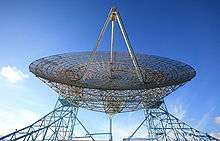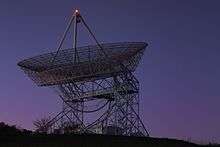Stanford Dish
The Dish, also known as the Stanford Dish, is a radio antenna in the Stanford foothills. The 150-foot-diameter (46 m) dish was built in 1961 by the Stanford Research Institute (now SRI International). The cost to construct the antenna was $4.5 million, and was funded by the United States Air Force.[1] In the 1960s the Dish was used to provide information on Soviet radar installations by detecting radio signals bounced off the moon.[2]
 | |
| Alternative names | The Stanford Dish |
|---|---|
| Location(s) | California |
| Coordinates | 37°24′30″N 122°10′44″W |
| Organization | SRI International |
| Telescope style | radio telescope |
| Diameter | 150 ft (46 m) |
 Location of Stanford Dish | |


Later on, the Dish was used to communicate with satellites and spacecraft. With its unique bistatic range radio communications, where the transmitter and receiver are separate units, the powerful radar antenna was well-suited for communicating with spacecraft in regions where conventional radio signals may be disrupted.[3]
At one point, the Dish transmitted signals to each of the Voyager craft that NASA dispatched into the outer reaches of the solar system.[4] In 1982 it was used to rescue the amateur radio satellite UoSAT-1.[5]
Today
The dish is still actively used today for academic and research purposes.[6] It is owned by the U.S. Government and operated by SRI International. It is used for commanding and calibrating spacecraft and for radio astronomy measurements.[7]
Recreational route
The area around the Dish offers a popular 3.5 mile recreational trail, visited by an average of 1,500–1,800 people daily.[8] The trail around the dish is known for its rolling hills and beautiful views, which on a clear day extend to San Jose, San Francisco, and the East Bay. While hikers, walkers, and runners are welcome, biking and dogs at the dish are not allowed. The opening hours are as per the schedule below, roughly matching daylight hours:
| Jan | Feb | Mar | Apr | May | Jun | Jul | Aug | Sep | Oct | Nov | Dec | |
|---|---|---|---|---|---|---|---|---|---|---|---|---|
| opens (AM) | 6:30 | 6:30 | 6:00 | 6:00 | 6:00 | 6:00 | 6:00 | 6:00 | 6:30 | 6:30 | 6:30 | 6:30 |
| closes (PM) | 5:00 | 5:30 | 6:30 | 7:30 | 7:30 | 7:30 | 7:30 | 7:30 | 7:00 | 6:00 | 5:00 | 5:00 |
As of June 2018, 360 cows were grazing on the grounds of the Stanford Dish.[9] Stanford leases the land to farmers who own the cows.
References
- "Radar Dish Erected on SU Campus". The Stanford Daily. 140 (7). October 2, 1961. p. 1. Retrieved 4 December 2019.
- Eliot, Frank. "Moon Bounce Elint". CIA. Retrieved 25 March 2019. (Also available as scanned PDF)
- Tuchinsky, Evan. "Stanford Golf Course: A Historical Tour". Archived from the original on 10 March 2007. Retrieved 4 December 2019.
- "Voyager: The Grand Tour of Big Science". NASA. Retrieved 20 June 2015.
- Hora, Reenita Malhotra (2019-11-05). "Tech History: The Story Behind Stanford's Satellite Dish Hiking Trail in Palo Alto". Medium. Retrieved 2020-05-15.
- "Welcome to the Stanford Dish". Stanford University. Retrieved 26 May 2014.
- "Dish Radio Antenna". SRI International. Retrieved 27 December 2019.
- Kim, Ryan (29 April 2004). "Stanford University / Mountain lion attack jolts horse country / Dish Trail users still jog and hike -- but are wary". SFGate. Retrieved 25 March 2019.
- "Farm Report: At Last Count: 360". Stanford Magazine (May 2018).